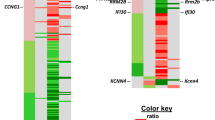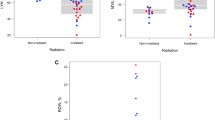Abstract
Haemopoietic tissues exposed to ionizing radiation are shown to exhibit increased macrophage activation, defined by ultrastructural characteristics and increased lysosomal and nitric oxide synthase enzyme activities. Macrophage activation post-irradiation was also associated with enhanced respiratory burst activities and an unexpected neutrophil infiltration. Examination of p53-null mice demonstrated that macrophage activation and neutrophil infiltration were not direct effects of irradiation, but were a consequence of the recognition and clearance of radiation-induced apoptotic cells. Increased phagocytic cell activity was maintained after apoptotic bodies had been removed. These findings demonstrate that, contrary to expectation, recognition and clearance of apoptotic cells after exposure to radiation produces both a persistent macrophage activation and an inflammatory-type response. We also demonstrate a complexity of macrophage activation following radiation that is genotype dependent, indicating that the in vivo macrophage responses to radiation damage are genetically modified processes. These short-term responses of macrophages to radiation-induced apoptosis and their genetic modification are likely to be important determinants of the longer-term consequences of radiation exposure. Furthermore, in addition to any effects attributable to immediate radiation-induced damage, our findings provide a mechanism for the production of damage via a ‘bystander’ effect which may contribute to radiation-induced genomic instability and leukaemogenesis.
This is a preview of subscription content, access via your institution
Access options
Subscribe to this journal
Receive 50 print issues and online access
$259.00 per year
only $5.18 per issue
Buy this article
- Purchase on Springer Link
- Instant access to full article PDF
Prices may be subject to local taxes which are calculated during checkout





Similar content being viewed by others
References
Adams DO, Hamilton TA . 1992 The Macrophage Lewis CE and McGee JOD (eds) Oxford University Press: Oxford pp. 75–114
Brockhaus F, Brune B . 1999 Oncogene 18: 6403–6410
Brune B, Golkel C, von Knethen A . 1996 Biochem. Biophys. Res. Commun. 229: 396–401
Duhrsen U, Metcalf D . 1990 Blood 75: 190–197
Giles KM, Hart SP, Haslett C, Rossi AG, Dransfield I . 2000 Br. J. Haematol. 109: 1–12
Giralt SA, Champlin RE . 1994 Blood 84: 3603–3612
Gorbunov NV, Pogue-Geile KL, Epperly MW, Bigbee WL, Draviam R, Day BW, Wald N, Watkins SC, Greenberger JS . 2000 Radiat. Res. 154: 73–86
Greenberger JS, Epperly MW, Jahroudi N, Pogue-Geile KL, Berry LA, Bray J, Goltry KL . 1996 Acta Haematol. 96: 1–15
Gregory CD . 2000 Curr. Opin. Immunol. 12: 27–34
Handel-Fernandez ME, Lopez DM . 2000 Macrophages A Practical Approach. Paulnock DM (ed) Oxford University Press pp .1–30
Iyer R, Lehnert BE . 2000 Arch. Biochem. Biophys. 376: 14–25
Jacks T, Remington L, Williams BO, Schmitt EM, Halachmi S, Bronson RT, Weinberg RA . 1994 Curr. Biol. 4: 1–7
Komarova EA, Diatchenko L, Rokhlin OW, Hill JE, Wang ZJ, Krivokrysenko VI, Feinstein E, Gudkov AV . 1998 Oncogene 17: 1089–1096
Lehnert BE, Goodwin EH . 1997 Cancer Res. 57: 2164–2171
Little JB . 2000 Carcinogenesis 21: 397–404
Lorimore SA, Kadhim MA, Pocock DA, Papworth D, Stevens DL, Goodhead DT, Wright EG . 1998 Proc. Natl. Acad. Sci. USA 95: 5730–5733
Lyng FM, Seymour CB, Mothersill C . 2000 Br. J. Cancer 83: 1223–1230
McCann SR, Lawler M, Bacigalupo A . 1993 Leuk. Lymphoma 10: 419–425
McKinney LC, Aquilla EM, Coffin D, Wink DA, Vodotz Y . 1998 J. Leukoc. Biol. 64: 459–466
Mole RH, Papworth DG, Corp MJ . 1983 Br. J. Cancer 47: 285–291
Mothersill C, Seymour C . 1997 Int. J. Radiat. Biol. 71: 421–427
Mothersill CE, O'Malley KJ, Murphy DM, Seymour CB, Lorimore SA, Wright EG . 1999 Carcinogenesis 20: 2273–2278
Narayanan PK, Goodwin EH, Lehnert BE . 1997 Cancer Res. 57: 3963–3971
Nathan C, Shiloh MU . 2000 Proc. Natl. Acad. Sci. USA 97: 8841–8848
Necas E, Sefc L, Sulc K, Barthel E, Seidel HJ . 1998 Stem Cells 16: 107–111
Nomura T, Kinuta M, Hongyo T, Nakajima H, Hatanaka T . 1992 J. Radiat. Res. 33: Suppl 109–123
Ponnaiya B, Cornforth MN, Ullrich RL . 1997 Radiat. Res. 147: 121–125
Prise KM, Belyakov OV, Folkard M, Michael BD . 1998 Int. J. Radiat. Biol. 74: 793–798
Silver LM . 1995 Mouse Genetics. Concepts and Applications Oxford University Press: Oxford pp. 195–263
Uchimura E, Watanabe N, Niwa O, Muto M, Kobayashi Y . 2000 J. Leukoc. Biol. 67: 780–784
Walburg HE, Congrove GE, Upton AC . 1968 Int. J. Cancer 3: 150–154
Watson GE, Lorimore SA, Clutton SM, Kadhim MA, Wright EG . 1997 Int. J. Radiat. Biol. 71: 497–503
Watson GE, Lorimore SA, Macdonald DA, Wright EG . 2000 Cancer Res. 60: 5608–5611
Wink DA, Vodovotz Y, Laval J, Laval F, Dewhirst MW, Mitchell JB . 1998 Carcinogenesis 19: 711–721
Wood W, Turmaine M, Weber R, Camp V, Maki RA, McKercher SR, Martin P . 2000 Development 127: 5245–5252
Wright EG . 1998 Int. J. Radiat. Biol. 74: 681–687
Wu L-J, Randers-Pehrson G, Xu A, Waldren CA, Geard CR, Yu ZL, Hei TK . 1999 Proc. Natl. Acad. Sci. USA 96: 4959–4964
Wyllie AH, Kerr JFR, Currie AR . 1980 Int. Rev. Cytol. 68: 251–306
Xu W, Liu L, Smith GC, Charles IG . 2000 Nature Cell Biol. 2: 339–345
Yamamoto K, Johnston RB . 1984 J. Exp. Med. 159: 405–416
Yoshida K, Nemoto K, Nishimura M, Seki M . 1993 Leuk. Res. 17: 437–440
Zhou H, Randers-Pehrson G, Waldren CA, Vannais D, Hall EJ, Hei TK . 2000 Proc. Natl. Acad. Sci. USA 97: 2099–2104
Acknowledgements
The authors thank R Mitchell, S Macfarlane, J Gibbs, N Kernohan, M Boylan and R Pleass. The research was supported by grants from the Medical Research Council, the European Commission and the Leukaemia Research Fund.
Author information
Authors and Affiliations
Corresponding author
Rights and permissions
About this article
Cite this article
Lorimore, S., Coates, P., Scobie, G. et al. Inflammatory-type responses after exposure to ionizing radiation in vivo: a mechanism for radiation-induced bystander effects?. Oncogene 20, 7085–7095 (2001). https://doi.org/10.1038/sj.onc.1204903
Received:
Revised:
Accepted:
Published:
Issue Date:
DOI: https://doi.org/10.1038/sj.onc.1204903
Keywords
This article is cited by
-
Alpha Particle–Emitting Radiopharmaceuticals as Cancer Therapy: Biological Basis, Current Status, and Future Outlook for Therapeutics Discovery
Molecular Imaging and Biology (2023)
-
Therapy sculpts the complex interplay between cancer and the immune system during tumour evolution
Genome Medicine (2022)
-
A Mouse Model for Skeletal Structure and Function Changes Caused by Radiation Therapy and Estrogen Deficiency
Calcified Tissue International (2020)
-
Radiation-Induced Bystander Effect is Mediated by Mitochondrial DNA in Exosome-Like Vesicles
Scientific Reports (2019)
-
Intercellular communications-redox interactions in radiation toxicity; potential targets for radiation mitigation
Journal of Cell Communication and Signaling (2019)



